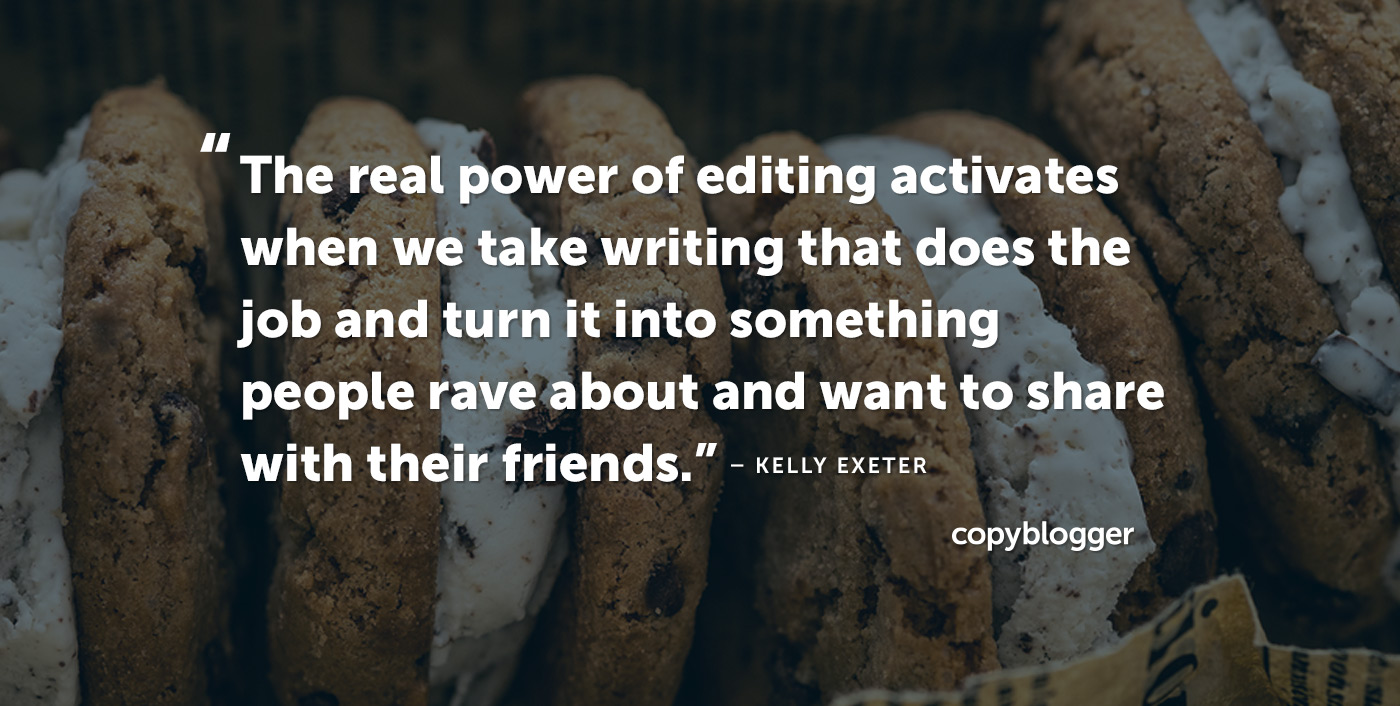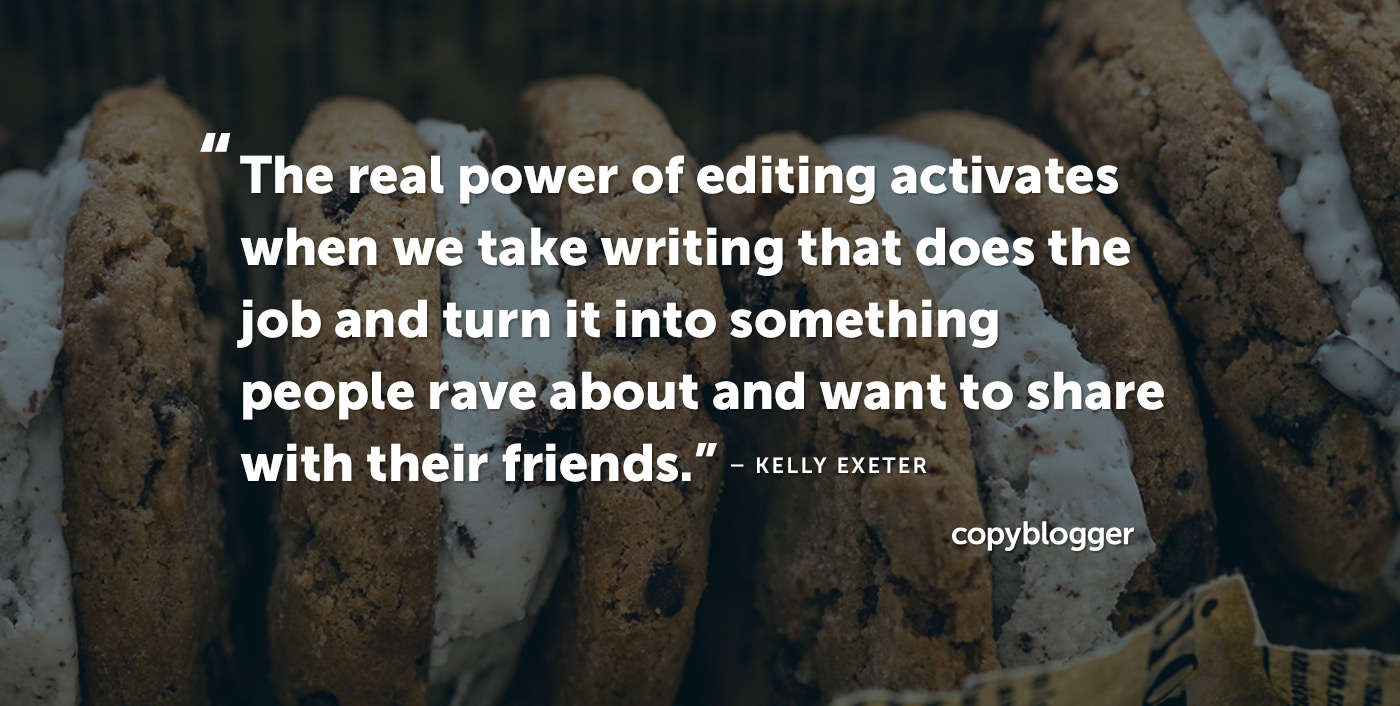What’s this got to do with writing? But to me, “publishable” is the equivalent of “vanilla.” To me, the real power of editing activates when we take writing that is vanilla (does the job) and turn it into chocolate chip cookie dough (something people rave about and want to share with their friends). Before you can turn a piece of vanilla writing into chocolate chip cookie dough, however, you need to be sure it really is at the vanilla (i.e., technically sound) stage. The next structural element we need to look at is our build This is where you introduce your idea to the reader and show them “what is.” Then you tell them why they should care by showing them “what could be.” In the introduction of this post, I showed you “what is” — vanilla ice cream. Essentially, it’s where you deliver on the promise you’ve made in your title. But more often than not, this is the part of the editing process where you need to do some re-writing and “hole filling.” Step #3: Remove roadblocks Roadblocks are things that make the reader stop and go … “Huh?” It’s important to remove these because there are so many things our readers can be doing today. The final most common type of roadblocks are sentences or paragraphs you love because they’re awesome and make you sound super-smart. If you read through your piece and it doesn’t feel like it flows very well, but your structure is sound, then you may need to use linking words like “but,” “and,” and “however” between your sentences. Like this: He often does this in essays and books to say, “Okay, I’ve finished that thought, and now I want to start a new one, but I have no way of segueing smoothly from one to the other.” Step #5: Line editing Now, this is what most of us think of when we think of editing. Check your use of “that.” Ninety-five percent of the time, you can remove the word “that” from a sentence and the sentence’s meaning won’t change.

Let’s talk about vanilla ice cream.
If you’re like most people, you find vanilla ice cream quite inoffensive.
You neither love nor hate it — i.e., it doesn’t inspire strong feelings in you.
And if you’re eating vanilla ice cream, it’s unlikely you’re raving about it to anyone.
Now I want you to think about Ben and Jerry’s Chocolate Chip Cookie Dough ice cream.
I bet that ice cream inspires strong feelings in you!
I bet if you had a big bowl of that in front of you, there’d be a huge smile on your face and you’d want to tell anyone who’d listen how good it is.
What’s this got to do with writing?
Well, many of us have perfected the art of writing “vanilla ice cream.”
Vanilla writing is both technically sound and inoffensive.
Vanilla writing “does the job” in the absence of anything better.
And the truth is, perfecting the art of writing “vanilla” is necessary if you want to earn a living as a writer.
The economic and time constraints imposed on us by our clients, plus our need to invoice quickly (so we can put food on the table), dictates that we need to be able to consistently churn out writing that is technically sound and “does the job.”
Vanilla writing pays the bills.
But sometimes, we want to produce writing that really moves people and inspires them to take action.
Sometimes we want our writing to provoke such strong feelings in people, they feel compelled to tell their friends, “Hey! Read this!”
Sometimes, we want to produce the writing equivalent of chocolate chip cookie dough ice cream.
The good news is, there’s a way to turn vanilla into chocolate chip cookie dough. You just need time, and a few extra ingredients.
The power of editing
Most people see editing as the process of turning a messy first draft into something that’s publishable. And yes, editing does do that.
But to me, “publishable” is the equivalent of “vanilla.”
To me, the real power of editing activates when we take writing that is vanilla (does the job) and turn it into chocolate chip cookie dough (something people rave about and want to share with their friends).
Yes, the editing process for the latter involves a few more steps than you’re used to, but I promise, it’ll be worth it.
Before you can turn a piece of vanilla writing into chocolate chip cookie dough, however, you need to be sure it really is at the vanilla (i.e., technically sound) stage.
You also need to meet these three requirements:
- You know exactly who the ideal reader is,
- You know what promise you’re making to them, and
- Your piece contains all the key information required to deliver on the promise.
If you have all of this in hand, it’s time to edit!
Step #1: High-level pass
This is the stage where knowing exactly who you’re writing for, and what you’re trying to say is crucial.
Because the first thing you need to do is go through your draft and delete anything that is not relevant to the promise you’re making.
When I first started putting this post together, many of the things I talked about were general writing tips. They were great tips, but completely irrelevant to the promise I was making — which was how to edit, not how to write.
The second thing you need to do is check your examples.
If the ideal reader for your piece is a doctor, but all your examples are about builders, you need to change your examples. (If you don’t, your piece won’t resonate.)
Finally, you need to check your sub-headings.
If you promise “5 secrets to great writing” in your title and all your sub-headings are actually “5 mistakes people make when they’re writing,” then you need to either change your title or your sub-headings.
Step #2 : Structure
A neat and tidy structure for any piece of writing is a three-part structure: beginning, middle, end. Or, my personal favorite: hook, build, payoff.
Let’s start with your hook
First, check you have one. The hook appears very early in a piece, and must capture your reader’s attention.
(Which is why you must know who the reader is.)
For example, I hooked you at the start of this article by connecting editing — something many writers don’t like doing — with ice cream, which pretty much everyone likes eating.
If your piece is missing a hook, and you’re not sure how to give it one, I break down five common hooks here.
It’s also worth noting that writers often bury their hooks two paragraphs into their content.
I can’t tell you how many “first two paragraphs” I’ve deleted in my time. All that backstory you’re giving, the reader doesn’t care.
Start with the bit that captures their attention, and then carry on from there. (If you really need backstory for context, you can introduce it later.)
The next structural element we need to look at is our build
This is where you introduce your idea to the reader and show them “what is.”
Then you tell them why they should care by showing them “what could be.”
In the introduction of this post, I showed you “what is” — vanilla ice cream. It’s “does the job” writing.
The problem is, no one’s Instagramming vanilla ice cream or telling their friends about it.
Then I showed you “what could be” — chocolate chip cookie dough ice cream.
Basically, I sold you the dream! Now I need to deliver on that dream.
And I do that via …
The final structural element: the payoff
Many writers think their final line is the payoff, but that’s rarely the case.
More commonly, it’s the six points, or the 10 tips,…

COMMENTS